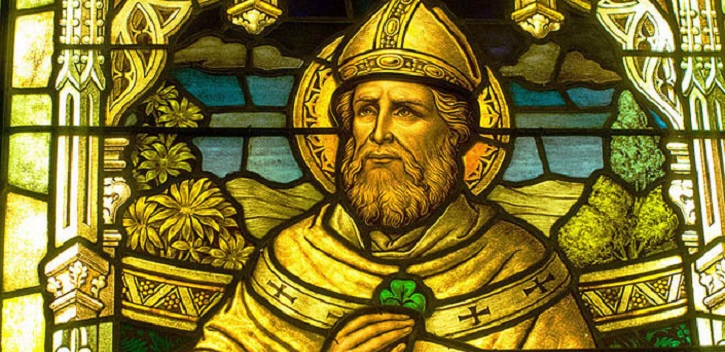Was St Patrick married?

St Patrick has been associated with snakes and shamrocks but the fact that he had a wife has largely been confined to the annals of history according to a UCC folklorist.
In the old Irish calendar the day after St Patrick's Day is Sheelah's Day but what is less known is that Sheelah was Patrick’s wife.
Shane Lehane, Department of Folklore and Ethnology/Béaloideas, UCC, says Sheelah was Patrick's "other half" and that the March 17th celebrations were extended for an additional 24 hours to commemorate her life.
Lehane observes that antiquarian journals and newspaper accounts of the 18th and 19th centuries in Ireland indicate the wide-spread belief that St Patrick had a wife.
"Pre Famine, pre-1845, if you go back to the newspapers in Ireland they talk not just about Patrick's Day but also Sheelah's Day. So I wondered where this came from? You have Paddy's day on the 17th and it continues on to Sheelah's day. I came across numerous references that Sheelah was thought to be Patrick's wife. She was his other half. The folk tradition has no problem with such detail. The fact that we have Patrick and Sheelah together should be no surprise. Because that duality, that union of the male and female together, is one of the strongest images that we have in our mythology."
An early reference to the continued celebrations on March 18th, which was St Sheelah's day, is found in John Carr's 1806 The Stranger in Ireland.
Carr said that on the anniversary of St Patrick, the country people assembled in their nearest towns and villages and got very tipsy.
"From a spirit of gallantry, these merry devotees continue drunk the greater part of the next day, viz., the 18th of March, all in honour of Sheelagh, St. Patrick’s wife."
Lehane claims the fact that Patrick had a wife is a really fascinating angle from a feminist point of view.
"What I think is very interesting is that people in Ireland in the past had no problem whatsoever accepting that Patrick had a wife. The church was very strong and during the period of Lent from Ash Wednesday right through to Easter Sunday you had major prohibitions. However, folk tradition was such that Patrick afforded a special dispensation and Irish people were allowed to celebrate Patrick's day which always fell in the middle of Lent. It seems to have been extended to the 18th of March and was a continuation of celebrations. They continued to drink on Sheelah's day and there is a sense that the women were more involved in the celebrations on the 18th. So there is a feminist angle in there."
Lehane has unearthed references to Sheelah's day in the Freeman's Journal of 1785, 1811 and 1841. There are also many accounts in the 19th century Australian Press evidencing the observance of Sheelah's day, usually in the context of the consumption of too much alcohol.
He says whilst the feast day is largely forgotten about in Ireland, Sheelah still has a keen presence in the history of Newfoundland, Canada.
"St Sheelah's Day was news to me. I thought it was amazing, as all memory of her seems to have died out here. Sheelah and Patrick, at one time, came to represent the ubiquitous Irish couple. Paddy and Sheelah became a byword for all Irish people. Sheelah has been forgotten altogether except in Newfoundland, Canada and in Australia. Irish people headed over to Newfoundland from the late 1600's. And they brought over with them this tradition of Sheelah and Sheelah's Day. Tim Pat Coogan once remarked that Newfoundland is the most Irish place in the world outside of Ireland."
Lehane says perhaps the most enduring legacy of Sheelah is the so-called "Sheelah's Brush" as the name given by Newfoundlanders and Atlantic Canadians to a winter snowstorm that falls after St Patrick's Day.
Sometimes referred to as "Sheelah's Broom" - or if the snowstorm is mild with only a bare covering of snow, "Sheila's Blush" - it is still referred to respectfully by meteorologists and fisherman in that part of the world.
Lehane suggests that perhaps the key to understanding the inherited notion that St Patrick had a wife, Sheelah, is to explore the hugely interesting archaeological manifestation that also bears her name: the Sheelah-na-Gig.
"Sheela-na-Gig is a basic medieval carving of a woman exposing her genitalia. These images are often considered to be quite grotesque. They are quite shocking when you see them first. Now we look at them very much as examples of old women showing young women how to give birth. They are vernacular folk deities associated with pregnancy and birth."
Lehane proposes that it is time to revisit and embrace the story of Sheelah.
"Sheelah represented, for women in particular, a go-to person because she represented the female. The Sheela-na-Gig is a really important part of medieval folk tradition. She is an important folk deity. The figure of Sheelah was perhaps much bigger than suggested by the scant mentions we find in the old newspaper accounts. She would have been massively important. She represents a folk personification, allied to, what can be termed, the female cosmic agency, and being such, would have played a major role in people’s everyday lives. It is a pity that the day has died out. But maybe we will revive it. I am sure Fáilte Ireland would be delighted with it. I think it would be a great idea!"
For more information about Folklore and Ethnology/Béaloideas at UCC visit http://www.ucc.ie/en/bealoideas/
Media: For more information contact Ruth Mc Donnell, Head of Media and PR, Office of Marketing and Communications, UCC Mob: 086-0468950
